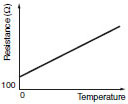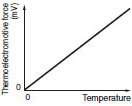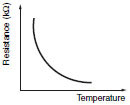Question
What are the types and characteristics of temperature sensors for Controllers?
Answer
Refer to the following table.
| Type | Principle and characteristics | Advantages | Disadvantages | Element type | Class | ||||
| Platinum resis- tance thermom- eter | The electrical resistance of the metal used by platinum resistance thermometers has a fixed relationship to the temperature. Therefore, a platinum wire with extremely high purity is used for the resistor.  | High precision | Expensive Easily influenced by lead wire resistance (OMRON minimizes influence by using a 3-conductor system.) Slow thermal response Low resistance to shock and vibration | JPt100 Pt100 | JIS Standard | ||||
| Class | Tolerance | ||||||||
| Class A | ± (0.15+0.002 | t |) °C | ||||||||
| Class B | ± (0.3+0.005 | t |) °C | ||||||||
| Note: | t | represents the absolute value of the temperature range. | |||||||||
| Thermo- couple | Thermocouple temperature sensors are constructed using two dissimilar metals that are joined together. The junctions are called the measuring junction and the reference junction (output terminal side). A thermoelectromotive force is generated between the junctions with a fixed correlation to the temperature providing the difference in temperature. Therefore, the temperature at the measuring junction can be determined from the thermoelectromotive force when a fixed temperature is maintained at the reference junction. Thermocouple temperature sensors are capable of measuring the highest temperatures among contact temperature sensors by using this measurement method.  | Broad temperature range High- temperature measurement High resistance to shock and vibration Fast thermal response | Compensating conductors are required when extending the lead wires | K (CA) J (IC) R (PR) | JIS Standard for Thermocouples | ||||
| Material code | Model name | Tempe- rature range | Class | Tolerance (See note.) | |||||
| R | PR | 0°C to 1,600°C | Class 2 (0.25) | ±1.5°C or ±0.25% of measured temperature | |||||
| K | CA | 0°C to 1,200°C | Class 2 (0.75) | ±2.5°C or ±0.75% of measured temperature | |||||
| J | IC | 0°C to 750°C | Class 2 (0.75) | ±2.5°C or ±0.75% of measured temperature | |||||
| Note: The tolerance is either the value in °C or %, whichever is larger. | |||||||||
| Ther- mistor | Temperature Characteristics  | Fast thermal response Small error due to lead wire resistance | Limited temperature range Low resistance to shock | Thermistor | JIS Standard Class 1 | ||||
| Measured temperature | Tolerance | ||||||||
| -50 to 100°C | ±1°C max. | ||||||||
| 100 to 350°C | ±1% max. of measured temperature | ||||||||


